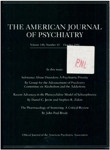Sleep EEG and DST findings in anergic bipolar depression
Abstract
The authors report sleep EEG and dexamethasone suppression test (DST) findings for a homogeneous sample of anergic bipolar depressed outpatients (bipolar I, N = 7; bipolar II, N = 19) characterized by motor retardation, volitional inhibition, hypersomnia, or weight gain and sleep EEG findings for 26 age- and sex-matched normal control subjects. Sleep architecture was abnormal in bipolar depression, particularly with respect to little stage 1 sleep. The biological profile of an anergic episode of bipolar depression did not include a shorter than normal mean REM latency, poor sleep continuity, or abnormally low amounts of stages 3 and 4 sleep, and only three (13%) of 23 patients manifested cortisol nonsuppression.
Access content
To read the fulltext, please use one of the options below to sign in or purchase access.- Personal login
- Institutional Login
- Sign in via OpenAthens
- Register for access
-
Please login/register if you wish to pair your device and check access availability.
Not a subscriber?
PsychiatryOnline subscription options offer access to the DSM-5 library, books, journals, CME, and patient resources. This all-in-one virtual library provides psychiatrists and mental health professionals with key resources for diagnosis, treatment, research, and professional development.
Need more help? PsychiatryOnline Customer Service may be reached by emailing [email protected] or by calling 800-368-5777 (in the U.S.) or 703-907-7322 (outside the U.S.).



